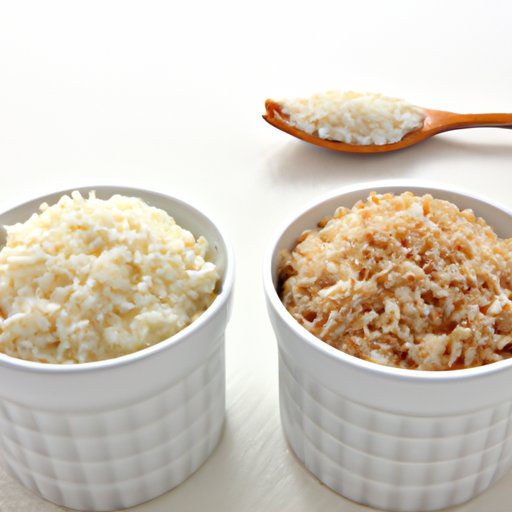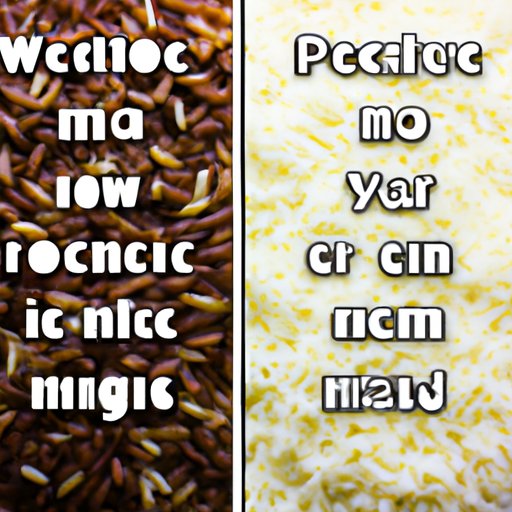Introduction
Rice is one of the most widely consumed grains in the world, with more than 7 billion people depending on it as a staple food. But when it comes to health, there is often confusion about whether brown rice or white rice is the better option. This article aims to explore the differences between these two types of rice and help readers decide which is healthier.

Comparing the Nutritional Benefits of Brown Rice and White Rice
When comparing the nutritional value of brown and white rice, it’s important to consider the macronutrients, vitamins, and minerals present in each type. In terms of macronutrients, both contain similar amounts of carbohydrates and protein, but brown rice has more dietary fiber than white rice.
In terms of vitamins and minerals, both types of rice are good sources of B vitamins and minerals such as manganese and selenium. However, brown rice has higher levels of vitamin E, thiamine, niacin, and magnesium than white rice.

Exploring the Healthiest Option for Rice Lovers
Fiber is an important component of a healthy diet, and brown rice contains significantly more fiber than white rice. Studies have shown that consuming fiber-rich foods can help reduce the risk of heart disease, diabetes, and obesity. Additionally, fiber helps to keep you feeling fuller for longer and can aid in weight loss.
The glycemic index (GI) measures how quickly a food affects your blood sugar levels. White rice has a higher GI than brown rice, meaning it can cause a spike in blood sugar levels. A high GI can lead to unhealthy cravings, fatigue, and mood swings. On the other hand, brown rice has a lower GI, meaning it is digested more slowly and has less of an effect on blood sugar levels.

Highlighting the Pros and Cons of Brown and White Rice
Brown rice is packed with nutrients and boasts a long list of health benefits, including improved digestion, reduced risk of diabetes, and lower cholesterol levels. It is also a great source of plant-based protein, making it a popular choice for vegetarians and vegans. However, brown rice takes longer to cook, so if you’re short on time this may not be the best option.
White rice is easier to prepare and digest, which makes it a popular choice for those who don’t have much time or who experience digestive issues. Additionally, white rice has a milder flavor than brown rice and can act as a blank canvas for a variety of dishes. While white rice has some nutritional benefits, it is usually stripped of its outer bran layer, leaving it with fewer vitamins, minerals, and fiber than brown rice.
Examining the Effects of Cooking Processes on Brown and White Rice
The way you cook your rice can also affect its nutritional value. When boiling brown rice, the boiling process can leach out some of the nutrients, such as vitamin B1. To preserve the maximum amount of vitamins and minerals, it is best to limit the boiling time to 20 minutes or less. On the other hand, baking brown rice can help to preserve the nutritional content.
When it comes to white rice, boiling can help to preserve the nutrients, while baking and stir-frying can strip away some of the nutritional content. The best way to cook white rice is to boil it and then let it sit for 10 minutes before serving. This will help to preserve the nutritional content and make it easier to digest.
Conclusion
In conclusion, brown rice is generally considered the healthier option due to its high fiber content, lower glycemic index, and greater nutrient content. However, white rice has some benefits, such as ease of preparation and a milder flavor. Ultimately, the best option for you depends on your personal preferences and needs. No matter which type of rice you choose, it is important to remember to practice healthy cooking techniques to ensure you get the most nutritional benefit from your meal.
(Note: Is this article not meeting your expectations? Do you have knowledge or insights to share? Unlock new opportunities and expand your reach by joining our authors team. Click Registration to join us and share your expertise with our readers.)
